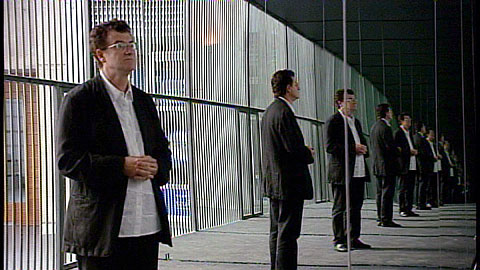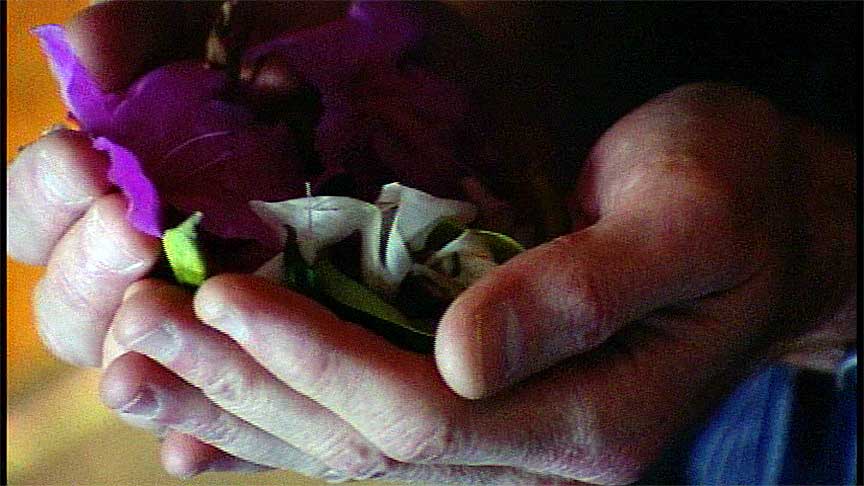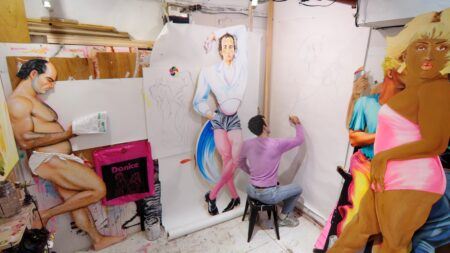Interview
“The Gramsci Trilogy”

Alfredo Jaar. Infinite Cell (2004) from the Gramsci Trilogy. Production still from the Art in the Twenty-First Century Season 4 episode, Protest, 2007. © Art21, Inc. 2007.
Artist Alfredo Jaar discusses his three-part installation work, The Gramsci Trilogy.
ART21: What is the background for your work, The Gramsci Trilogy?
JAAR: I was invited to do a series of exhibitions in Italy in 2005. I wanted to make an homage to Antonio Gramsci and Pier Paolo Pasolini—two Italian thinkers whom I admire greatly. Gramsci was one of the first thinkers who really believed in the power of culture to affect social and political life. And Pasolini was an artist like no other—a thinker, a filmmaker, a poet, writer, and critic. What brought me to Infinite Cell was Pasolini’s comment, that culture is a prison and that we intellectuals have to get out of that prison: enough of me speaking to you, and you speaking to me, me applauding you, and you applauding me—let’s get out, let’s reach a larger audience. This could have been my motto for many, many years.
Infinite Cell, which is part of The Gramsci Trilogy, is a metaphorical representation of the cell where Gramsci, one of the founders of the Italian Communist Party, died—imprisoned by the Fascist government of Mussolini. It’s also a direct reference to Pasolini’s writings and thinking.
ART21: Mirrors seem to reoccur in a lot of your pieces.
JAAR: I’m obsessed with mirrors. A mirror is a simple object of daily life, and the perfect articulation of the narcissism of our society—a society that only cares for itself. In Infinite Cell, it’s about seeing ourselves in infinite projection and thinking about what we want to do as artists, as intellectuals. What do we want to say as producers of culture? And to whom are we speaking? Am I my public, or is it someone else? It also has to do with the horrors of the twenty-first century. And so, in a way, this piece asks, “How do we make art in the world, the way it is now? How do we make art today?”
ART21: How do you expect the audience to react to Infinite Cell?
JAAR: What I’m expecting from the audience is that they feel their bodies compromised by the space. I think this is a key element of all my installations. I think that the body has a language, and when the audience enters this place, their body language will change. I’m interested in these shifts. It’s the capacity of architecture and art to produce those changes. They are merely physical changes, but of course the metaphor here is that this also suggests the possibility of an intellectual change, a mental shift. That’s what all the works try to do.
ART21: Are you also anticipating a kind of emotional response?
JAAR: This is probably one of my most emotionally charged works. No doubt about it. And this work has a very universal life—as all countries have histories of horror. Chile (where I was born) does have its share. So, in a way, I was aware that this piece would resonate in a very specific way. And I was interested in that, too.

Production still from the Art in the Twenty-First Century Season 4 episode, Protest, 2007. Segment: Alfredo Jaar. © Art21, Inc. 2007.
ART21: Can you talk about Let One Hundred Flowers Bloom?
JAAR: It is based on a Chinese poem that Mao used in a campaign in the 1950s, calling upon Chinese intellectuals to critique the Revolution from within. They were afraid, but the campaign lasted a year and, at the end, the intellectuals were convinced that Mao wanted to hear their opinions. They questioned the essence of the Revolution. Mao was unhappy with their reactions, and what the intellectuals feared actually happened. They were imprisoned, tortured, and quite a few were killed. This piece stands as a metaphor for the struggle of intellectuals all over the world. Here are a hundred flowers being subjected to contradictory forces.
When you enter the space, some flowers will be alive, some struggling, some dead. On one hand, they’re being fed with water and light, and on the other hand, they are being killed by industrial winds and strong cold. The flowers will be dying continuously, but we will keep replacing them. I’m interested in the audience witnessing some dead flowers when they enter the freezer-like structure and feeling what the plants feel. It’s another metaphor, to involve the public in an active and physical way, to move them to make intellectual projections. Intellectuals may die—they may be suppressed—but ideas never die.
The show will be up during the spring and the summer. When you enter, it’s going to be fifteen to twenty degrees below the normal temperature outside. I wanted the audience to feel the wind complemented by the cold. It’s going to be really a physical experience to come here. The director of the gallery is worried; she thinks that everyone will get a cold in the middle of the summer, and it’s not a good idea.
ART21: The cold seems related to image of the prison cell.
JAAR: Yes, the suggestion of the cell is found throughout The Gramsci Trilogy. Even though you are looking at this beautiful garden, all the negative connotations of the cell are here. They are present in the materials used, the proportions, the scale, the light—everything is designed in order to make the spectator feel curiously uncomfortable, in spite of looking at this gorgeous spectacle of flowers.
ART21: What do the fallen flowers represent for you?
JAAR: The flowers keep dying, basically suggesting that we cannot stop the flow of ideas—intellectuals thinking about a better world, speculating, asking questions. I’m trying to articulate this idea that maybe we human beings disappear, but ideas will stay.
ART21: What is the connection between The Gramsci Trilogy and Chile?
JAAR: What connects this particular work that was shown in Rome for the first time with the Santiago situation is that, instead of the video we had in Rome with Gramsci’s grave, here we are opening a window into the Alameda, the site of so many marches and protests in Chile. It’s the perfect sign of intellectual life in this country. Here, the past is always present. We had a very difficult period of history in the last twenty-five or thirty years, and there are many things that are still not resolved. Basically, Chileans are living in the past and in the future at the same time. Young people are being born in such a different country that it is difficult for them to even imagine the kind of conflicts that divided this country just a few years ago. It’s a totally new situation that they are discovering. And for them, it’s hard to believe that what happened in Chile ever really happened.

Production still from the Art in the Twenty-First Century Season 4 episode, Protest, 2007. Segment: Alfredo Jaar. © Art21, Inc. 2007.
ART21: What did happen?
JAAR: What you see outside, now—it seems so normal. But thirty-three years ago, there were tanks and people being killed. One of the most significant and tragic moments of this country (and I would say the world) was occurring. Here was the first democratically elected Socialist president in the history of the world, and that dream was dying on those avenues outside this window. By opening a little window into this gallery that happened to be on the Alameda, a world of connection is created. That’s the magic of art, and I think it’s extraordinary: the power to create connections, make bridges. It fascinates me.
ART21: Considering the fact that you are tackling such difficult subject matter, how do you explain the presence of beauty in your work?
JAAR: People describe me sometimes as a conceptual artist, as a political artist, with work of a strong political connotation or social content. I always reject those labels. I’m an artist, and believe it or not, I’m interested in beauty, and I’m not afraid of it. It is an essential tool to attract my audience, and sometimes I use it to introduce horror because the audience has to be seduced. If we learned anything from the activist art of the 1960s, it is that when you make that kind of work, people don’t even get close to you. They don’t want to see another drop of blood on the floor. So, beauty becomes a tool to bring the audience in.
And once they are closer, they discover other things. That’s a very good metaphor for what life is. We see beauty all around us, and we should never forget the beauty of life. But that doesn’t mean that we should just stay with beauty. We should not be afraid sometimes to confront beauty and horror. Let One Hundred Flowers Bloom, from the Gramsci Trilogy, does that in a very direct way.
ART21: Is your background in architecture prevalent in Let One Hundred Flowers Bloom?
JAAR: In this work, I think that the language of architecture is quite clear. The setup is responding to a very clear program. We wanted to create a situation where there were two opposing forces at play, and it was very important that these opposing forces were visible. So, it’s not arbitrary that you see all this tubing bringing the water—it’s a necessary element—and the same with the physical presence of the lights, and so on. Then, on the other hand, you feel the actual presence and effect of the ventilators. You feel the cold. So, basically, it’s a stage where this play is being staged for us. And the protagonists are flowers. But I hope some visitors will make the necessary projections and read beyond the flowers.
ART21: Can you talk about the differences between having this work installed in Italy, where it was first presented, and now in Chile?
JAAR: When you create a work that is site-specific and then this work travels, it starts accumulating new information. Of course, this cell in Santiago, Chile, is not the same cell [as the one] in Milan, Italy. As an artist, I have to be aware of the implications of moving a piece from one place to another. The Chilean audience will read this piece in a totally different way than they will read the piece in Milan. I think that one of the thoughts that they will have is the concept of justice in Chile because, after all these years, we are still talking about justice. Justice in democracy where we have a military that had such a power is a very complicated thing. And some are still waiting for justice.



